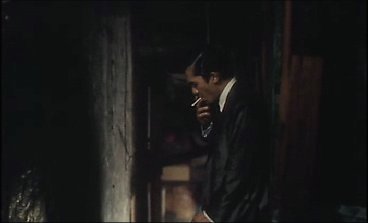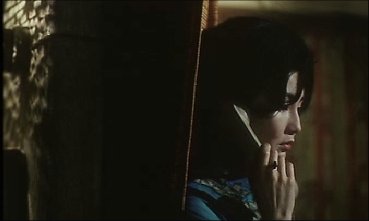|
Text and layout © Ed Shum, 2003. Ed Shum asserts the moral right to be identified as the author of this work |
|
Long Reviews |
|
And, as mentioned before, the rhythm of the soundtrack complements the camera too. For example, one scene features a relentless downpour, which stops after what feels like an age, with the camera cutting to the ripples spreading in a puddle - whilst the viewer feels the echoes of the sudden quietness. This scene reflects the cafe shot after the rainstorm in DoBW, the sudden silence, unbroken by dialogue, leaving one’s attention with the image. Then there is the scene where Tony and Maggie sit back to back against the wall that separates them, the camera swinging from one apartment to the other, rhythm dictated by the song on the radio requested by Maggie’s husband, the two leads inches apart but repressed by the reminder of Maggie’s husband’s presence, even if he is hundreds of miles away. This scene practically reads like an essay on WKW’s recurrent themes - the passing of irrecoverable time in the characters lives (it’s her birthday), the issues of space - physical and emotional, and the stretched longing played out on this vista. Analysis aside, the cinematography of the film as a whole is beautiful and rich, but less dazzling than in previous WKW films. |
|
Review of In The Mood For Love (2000) |
|
|
|
...Continued... [Page 4] |
|
End |
|
So what does it all add up to? As can probably be guessed from this review, ITMFL is both a reviewer’s dream and nightmare. The richness invites analysis and provides footholds on which interpretations can rest, but so much is unsaid and ambiguous that one can’t claim to truly interpret this film. In this sense, WKW stays true to his old form. But his previous movies weren’t open due to ambiguity but because they didn’t have the feel of films which could be comprehensively analysed. Whilst feeling and mood are prominent in ITMFL, it demands an analysis which makes the audience’s participation more detached than with other WKW films - whilst a viewer can interpolate to flesh out the movie’s open areas, one can’t quite create the pizzazz which WKW infused into some of his other work and communicated to us. There is still absolutely no doubt when watched, that this film has been created by a master, but whereas he shot us to the Hyperion with his imaginative and quirky inventiveness before, here he tries to coax us into providing the energy - something which we can’t do to WKW’s level. |
|
The reason why so many people like WKW is that he moves us yet he lifts us in a way which we could never have imagined. He is one of the few film-makers where we genuinely feel that he is two steps ahead of the audience’s expectations rather than vice versa. ITMFL does move, but perhaps ends up making us feel more helpless. WKW has always been called an optimist, but ITMFL doesn’t tally with this. Also, one feels when watching ITMFL that WKW may be listening to critics - always a dangerous move. As mentioned before, the radio request scene is a paradigm example of what many people see as WKW. Technically brilliant though it is, I found it less engaging than the ‘usual’ WKW tropes which always seem ad hoc, quirky and intuitive. The problem is that so many people (myself included) are inclined to explain WKW from what we know, yet we can’t know the creative process - so analysis as a spur to creativity is dangerous, especially for a director famed for his idiosyncratic inventiveness . |
|
This criticism is a small one though. It must be appreciated that WKW’s work creates such anticipation that it is never possible to satisfy all. That ITMFL thwarted expectations is in keeping with WKW’s modus operandi. On a personal level, it has to be said that the loss of a sense of profoundly human fun irreverence - the absence of the type of playful conceits which made WKW’s work lyrical - slightly dampens the feeling of joyful/awestruck exhilaration which usually attends me when watching his films. But having said this, ITMFL definitely strikes into new ground, and impressively too. It is a cliche that people often say WKW’s films are a meditation on loss and desire, but here that is true and the result is awe-inspiring in its scope and execution. Even if the result lacks the exhilaration which WKW is famed for creating, the movie takes longing and possibility to a new level of emotive film-making, and shows that WKW’s profound expression exists beyond the confines of a style. |
|
Unfinished sympathy: this scene is a paradigm example of how WKW manages to stretch the film’s longing, yet without giving too much away. This method invites an emotional input from the audience beyond mere observation - so what one sees is very much subjective. |
|
Page: |
|
Page: |

|
The game: WKW definitely strikes new ground with In The Mood For Love, yet he doesn’t lose sight of his characteristic strengths. The film remains a very open affair in terms of interpretation and appreciation - definitely a sign of WKW becoming more mature. The result is a trade-off of WKW’s characteristic pizzazz for a mode of filmmaking that is both subtle and still profound |
